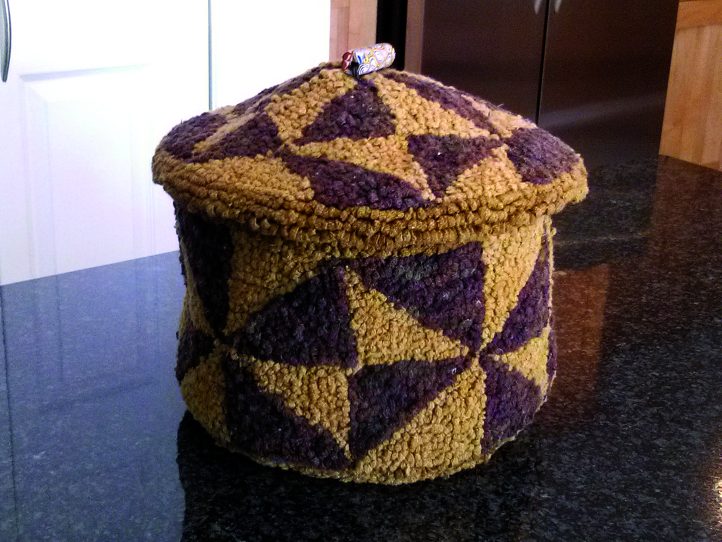
Kuba Dreams, 7″ diameter x 41⁄2″ tall; lid: 71⁄2″ diameter, 2″ tall. 2011. Designed and photographed by Susan Wertheimer David.
It is a sad day when an injury prevents someone from enjoying the form of art they’ve practiced for decades. In Susan Wertheimer David’s case, a broken wrist in 2012 meant she could no longer throw the quantity of forms she’d made as a professional potter.
But in what proves to have been fortuitous timing, she had begun to study rug hooking in late 2010. On vacation a few years earlier, she had met rug-hooking artist Rosemary Levin in Corea, Maine. Levin’s sense of color and design excited her and she thought she could give hooking a try.
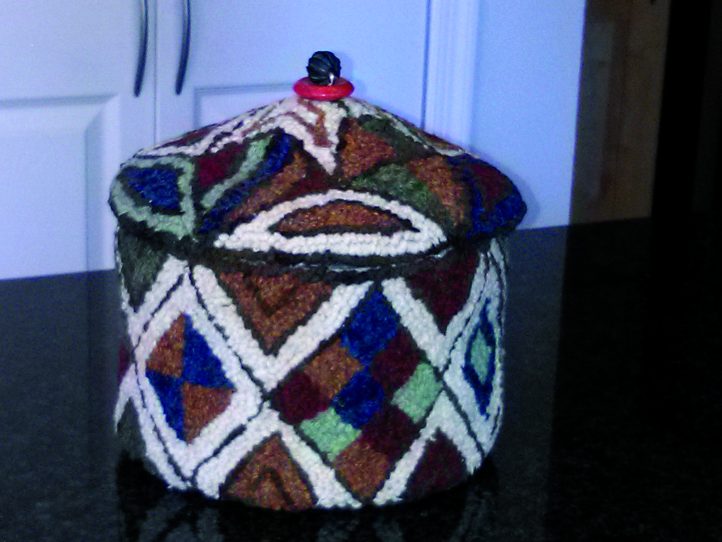
Turkish-textile-themed cylindrical box, 7″ diameter; 41⁄4″ tall; lid: 7″ diameter x 2″ tall. 2011–2012. Designed and photographed by Susan Wertheimer David.
David searched for a rug-hooking teacher near where she lived in Maryland and found Roslyn Logsdon’s class at Montpelier Arts Center in nearby Laurel. David liked Logsdon’s unique style and sense of color, though they differed from Levin’s. The work of both Logsdon and Levin pointed to the depth of artistic expression that’s possible with hooking—something that impressed David. She dove in.
But she had an aesthetic need for enclosed spaces and wanted to create three-dimensional forms with hooking as the medium. Logsdon suggested a flat design to begin with, so that David could gain experience hooking before trying a three-dimensional piece. That design was a simple bamboo stalk and included blocks of color she would work with in future projects.
David still had not hit upon the exact form that appealed to her. She had potted for 35 years, the last 20 of those utilizing the Japanese firing technique of raku to create ceramic boxes, among other forms. As a potter, the idea of an enclosed volume of space always intrigued her, especially when she made a fully closed form, allowed it to dry slightly, then cut an opening to create a lid and felt the whoosh of air escaping before firing it.
In 2012, she went to see “Weaving Abstraction: Kuba Textiles and the Woven Art of Central Africa” at the Textile Museum in Washington, D.C. A set of small, three-dimensional objects—circular, elliptical, and square, made of plain and dyed raffia—grabbed her. Her daughter Mira suggested she make a box by hooking it.
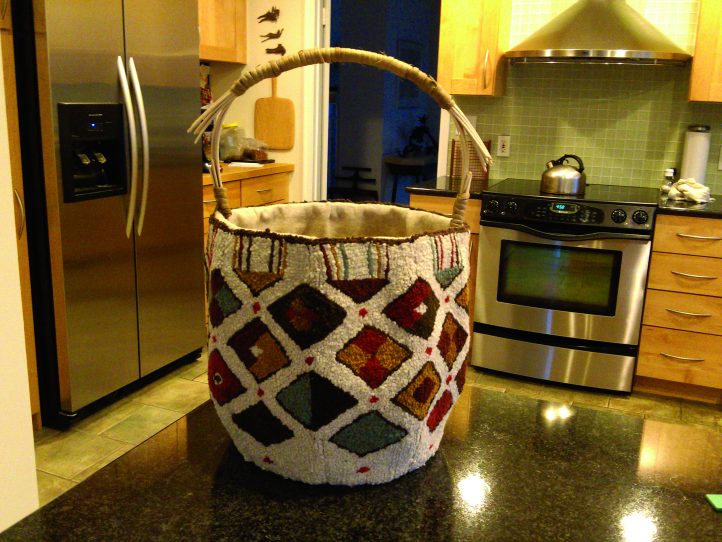
Turkish-textile-themed basket, 12″ tall (24″ tall with handle); 11″ diameter. 2012. Designed and photographed by Susan Wertheimer David.
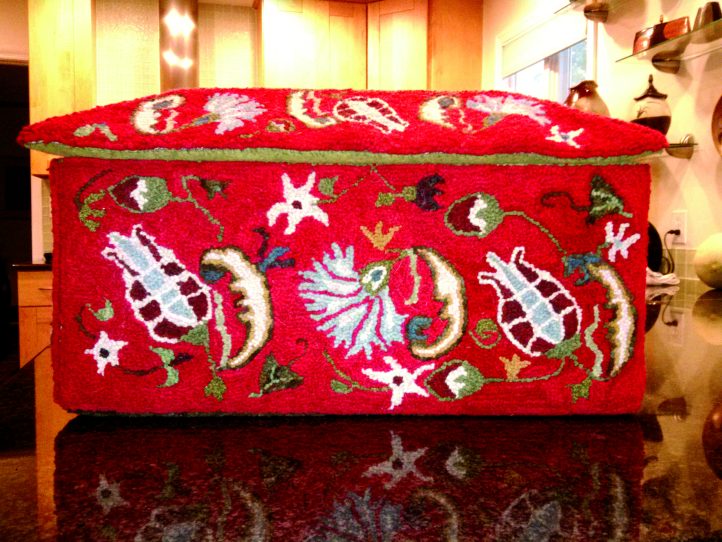
Sultan’s Garden (Mira’s box), 18″ wide x 6″ tall x 6″ deep; lid: 20″ wide x 2″ tall x 10″ deep. 2012. Designed and photographed by Susan Wertheimer David.
“The appeal of the box is in the sense of mystery of the interior volume and how I design the exterior surface,” says David. Unlike with raku, though, which leaves the final appearance somewhat to chance interactions between various combustibles, fire, and oxygen, she would know exactly how the exterior would turn out.
“I decided to do what seemed like a fairly straightforward cylindrical box with a lid,” David says. “I selected the Lantshoong motif from the ‘Weaving Abstraction’ exhibit.” The dark and the light in David’s box are similar to the colors of the raffia in the Kuba weavers’ boxes. And because she loves beads, she used an old African trade bead on the lid. She stores sewing supplies for putting hooked boxes together in this cylindrical box, which she calls Kuba Dreams.
Her next project, also a cylindrical box, was based on Turkish rug patterns. With the third project, also based on Turkish designs, David kept the form open at the top and added a handle she crafted of reed so that it’s a basket.
Despite Logsdon’s initial skepticism about creating hooked boxes, she has provided hours of advice on color, suggestions for compositions, and complete support, David says. “I continue to learn from Roslyn. Her enthusiasm and sense that hooking is the textile equivalent of painting is very exciting to me.”
After the first two cylindrical boxes and the basket, David wanted to make boxes for each of her three children.
Her fourth project was an oblong box with lid for daughter Mira. Ideas for it came when she traveled with Mira and her fiancé to Turkey. They visited many museums, and David was inspired by the Ottoman themes in the textiles. Mira’s box, Sultan’s Garden, is based on some of the themes and colors in the textiles, though not in the exact way they are presented, David says.
Beyond her inspirations from textile art motifs, David also looks to nature and landscapes. She tapped into nature in her fifth project, Secret Garden, an oblong box for oldest daughter Rachel, a New Orleans blacksmith artist who gardens for food, beauty, and relaxation. For Rachel’s box, David drew upon her daughter’s persimmon tree as well as the flowers she grows.
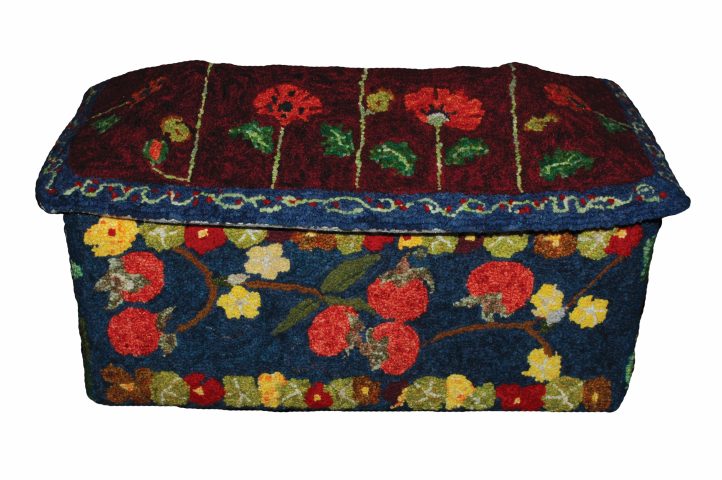
Secret Garden (Rachel’s box), 18″ wide x 8″ tall x 8″ deep; lid, 22″ wide x 2″ tall x 12″ deep. 2013.
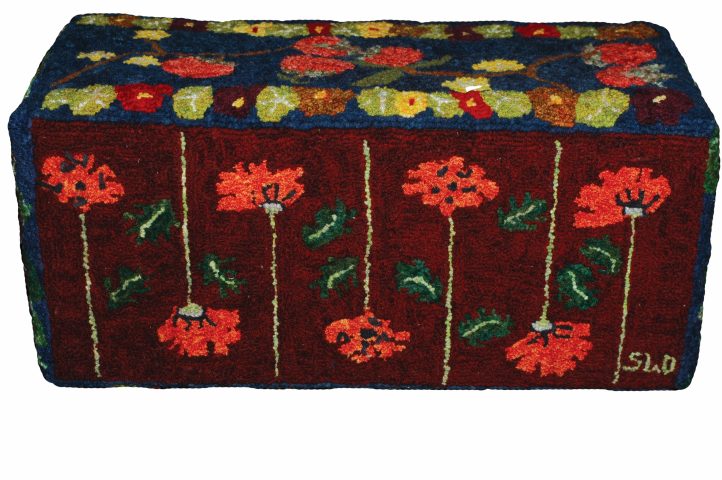
Secret Garden (Rachel’s box), 18″ wide x 8″ tall x 8″ deep; lid, 22″ wide x 2″ tall x 12″ deep. 2013.
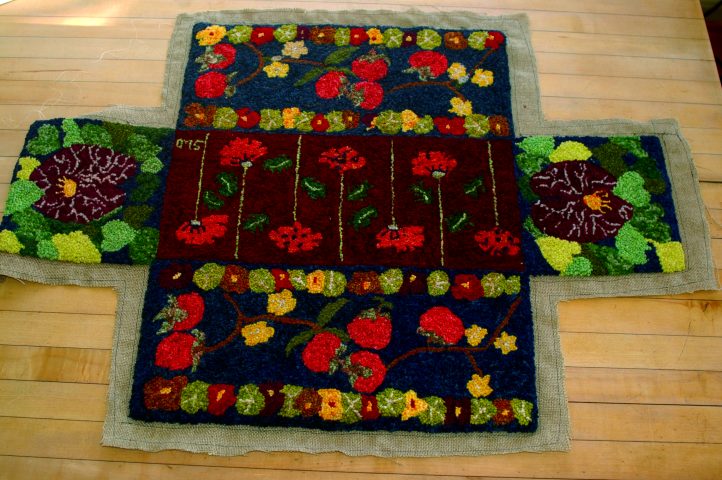
Secret Garden (Rachel’s box), 18″ wide x 8″ tall x 8″ deep; lid, 22″ wide x 2″ tall x 12″ deep. 2013. Designed and photographed by Susan Wertheimer David.
David’s sixth project, Inner Landscape, for son Toby, plays up his love of Japanese landscapes and his notions of how those landscapes form his own interior space.
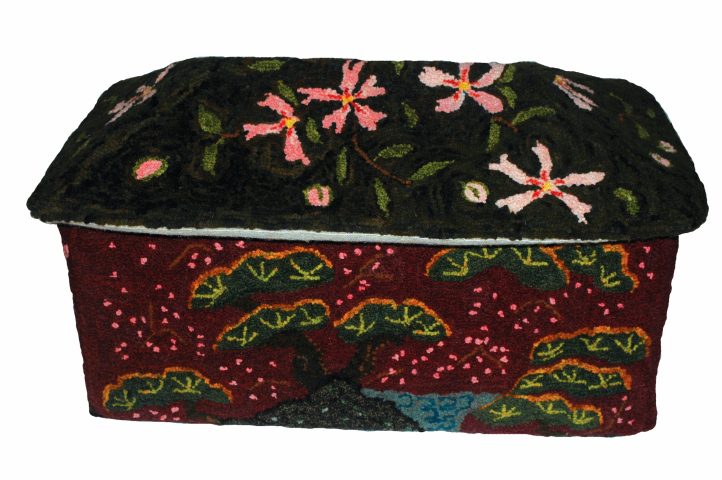
Inner Landscape (Toby’s box), 18″ wide x 8″ tall x 8″ deep; lid, 22″ wide x 2″ tall x 12″ deep. 2014.
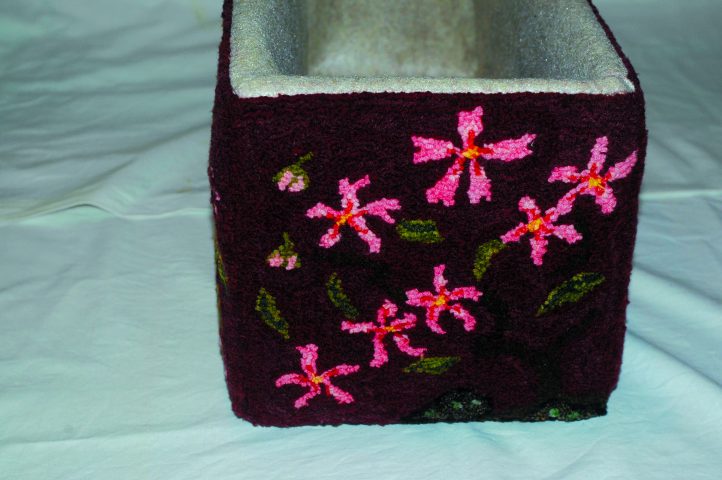
Inner Landscape (Toby’s box), 18″ wide x 8″ tall x 8″ deep; lid, 22″ wide x 2″ tall x 12″ deep. 2014. Designed and photographed by Susan Wertheimer David.
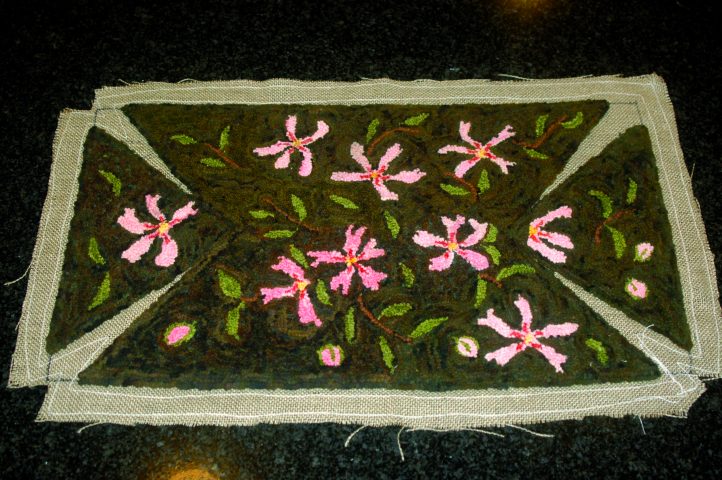
Inner Landscape (Toby’s box), 18″ wide x 8″ tall x 8″ deep; lid, 22″ wide x 2″ tall x 12″ deep. 2014. Designed and photographed by Susan Wertheimer David.
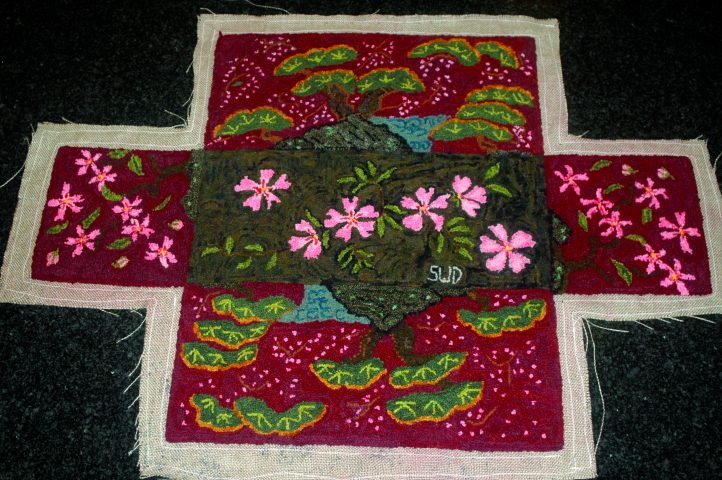
Inner Landscape (Toby’s box), 18″ wide x 8″ tall x 8″ deep; lid, 22″ wide x 2″ tall x 12″ deep. 2014. Designed and photographed by Susan Wertheimer David.
The box David is now working on integrates scenes from Maine, where she and her husband spend their summers. She has taken many photos the last couple of years they’ve visited. “You wouldn’t believe how many times I take the same photograph. I have years of photos of the same rock.” She laughs. But it’s easy to understand why the rocks would draw David’s interest.
“That part of Maine has these huge granite and basalt formations that welled up out of the earth,” she says. “The glaciers came through and scoured some of them. I am totally enamored by that combination of the light in Maine, which is extremely clear and vibrant, the rocks, which are in different colors, the water—the colors of the water—and then to throw into that mix, during the fall, the intensity of the colors of the trees.”
For the current box, “I have four very different scenes for the sides,” she says. “I’m putting a picture of the house on the bottom and the lid is going to be a windswept scene in Acadia National Park with the exposed granite and pine trees—six different scenes in one box. I like that.”
The challenges with hooking extend beyond composition and color when David creates the three-dimensional forms and boxes. Because she wants them to have a lid, she has to find a way to support the hooked material. She continues to experiment with this process.
For the first four—the two cylindrical boxes, the basket, and Mira’s box—David sewed sizing onto the hooked portions. Then she used the kinds of stays one finds in the bodices of certain dresses to provide even more support. This worked fine for the cylinders, but did not work well for Mira’s box, which, because of its length, has a larger amount of hooked material.
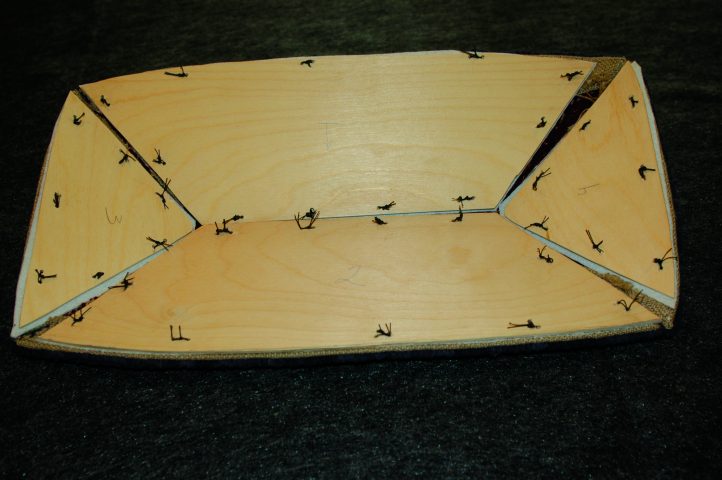
Underside of lid for Secret Garden (Rachel’s box). Designed and photographed by Susan Wertheimer David.
Experienced rug hookers, including Levin and classmate Churchill McKinney, made suggestions, such as utilizing wood within the box structure for support, which David did for Rachel’s and Toby’s boxes. The hardest part with those was to ensure she had the lid angle correct. Husband Alex cut the wood for her, and she shaved and sanded the edges to give them a rounded smoothness.
With all three boxes, she sewed sizing to the hooked material. With Rachel’s and Toby’s boxes, she then included quilt batting to further protect the hooking as well as lend softness. Then she drilled holes through the wood to sew the hooked material to the boxes. She eventually redid Mira’s box with wood to give it support.
With the boxes, “I sewed the seams of the box together as tightly as possible and left very little allowance because I didn’t want a lot of material bunching up,” she says. But she did not sew so tightly that it stressed the hooking. Felt lines the boxes’ interiors.
The acid in the wood and its potential effects on the hooked material concerns David. So for the Maine-scenes box, she plans to switch to acid-free foam core. She hopes the foam core will be strong, yet easier to work with.
Although David misses pottery, she also feels she did what she could in that medium. “I really felt satisfied with what I accomplished in clay. I would produce hundreds of pieces a year and there is such a different rhythm to that.”
David says she loves the colors and feel of wool as well as the sense of exploration in translating her ideas into hookings. And she appreciates hooking’s slower pace. With so many different patterns, there’s plenty to hold her attention and curiosity.
“It’s the perfect thing for me now,” she says. “I’m very happy to have found this.”
